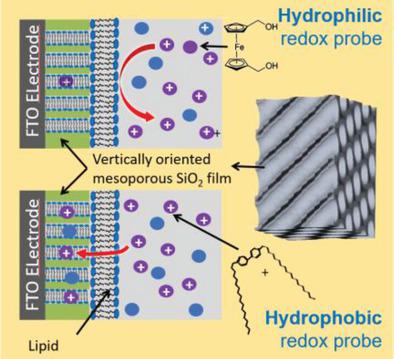当前位置:
X-MOL 学术
›
Adv. Mater. Interfaces
›
论文详情
Our official English website, www.x-mol.net, welcomes your feedback! (Note: you will need to create a separate account there.)
Nanoconfinement Effects on Redox Probe Transport in Lipid Assemblies on and in Mesoporous Silica Thin Films
Advanced Materials Interfaces ( IF 5.4 ) Pub Date : 2020-02-14 , DOI: 10.1002/admi.201901787 Shanshan Zhou 1 , Emma Guilfoil 1 , Yuxin He 1 , Suraj Nagpure 1 , Syed Z. Islam 1 , M. Arif Khan 1 , Stephen E. Rankin 1 , Barbara L. Knutson 1
Advanced Materials Interfaces ( IF 5.4 ) Pub Date : 2020-02-14 , DOI: 10.1002/admi.201901787 Shanshan Zhou 1 , Emma Guilfoil 1 , Yuxin He 1 , Suraj Nagpure 1 , Syed Z. Islam 1 , M. Arif Khan 1 , Stephen E. Rankin 1 , Barbara L. Knutson 1
Affiliation

|
Redox probe transport through supported lipid bilayers and nanopore‐confined lipid assemblies on silica thin films is examined using electrochemical impedance spectroscopy (EIS). These supported lipid systems are emerging biomimetic separation and sensor platforms. The ability to quantify the accessibility of the pore structure of the mesoporous silica thin films is demonstrated, which is essential for the incorporation of carriers into the lipids for selective solute transport. Redox probe molecules with varying hydrophilicity are used to compare ion transport in supported lipid pore‐spanning bilayers (enveloped bilayers) and novel lipid filled pores of mesoporous silica thin films. The films feature orthogonally oriented 8–10 nm cylindrical nanopores formed by deposition of P123‐templated silica sols onto chemically modified fluorine‐doped tin oxide. Nanopore accessibility is confirmed by EIS with hydrophilic probe 1,1′‐ferrocenedimethanol (FDM). Filling the pores with lipid 1,2‐dipalmitoyl‐sn‐glycero‐3‐phosphocholine results in a superior barrier (with roughly 1/9 the permeability) to transport of FDM compared to fragile enveloped lipid bilayers deposited by vesicle fusion. The pore‐confined lipids not only provide a better barrier to FDM, but also a better pathway for the transport across the films of a hydrophobic redox probe 1,1′‐dioctadecyl‐4,4′‐bipyridinium dibromide, with an ideal transport selectivity of 11 compared to FDM.
中文翻译:

纳米限制对介孔二氧化硅薄膜上及其中脂质组装中氧化还原探针转运的影响。
使用电化学阻抗谱(EIS)检查了氧化还原探针在硅胶薄膜上通过支持的脂质双层和纳米孔限制的脂质组装体的转运。这些支持的脂质系统是新兴的仿生分离和传感器平台。证明了量化介孔二氧化硅薄膜的孔结构可及性的能力,这对于将载体掺入脂质中以进行选择性溶质运输至关重要。具有不同亲水性的氧化还原探针分子可用于比较支持的脂质跨孔双层(包被的双层)和介孔二氧化硅薄膜的新型脂质填充孔中的离子传输。薄膜具有正交取向的8-10 nm圆柱形纳米孔,这些孔是通过将P123模板二氧化硅溶胶沉积到化学改性的掺氟氧化锡上而形成的。EIS使用亲水性探针1,1'-二茂铁二甲醇(FDM)证实了纳米孔的可及性。与通过囊泡融合沉积的易碎包膜脂质双层相比,用脂质1,2-二棕榈酰-sn-甘油3-磷酸胆碱填充毛孔可产生更好的屏障(渗透性约为1/9)。孔封闭的脂质不仅为FDM提供了更好的屏障,而且为跨疏水性氧化还原探针1,1'-二十八烷基-4,4'-联吡啶二溴化物的膜提供了更好的转运途径,具有理想的转运选择性与FDM相比,只有11个。1'-二茂铁二甲醇(FDM)。与通过囊泡融合沉积的易碎包膜脂质双层相比,用脂质1,2-二棕榈酰-sn-甘油3-磷酸胆碱填充毛孔可产生更好的屏障(渗透性约为1/9)。孔封闭的脂质不仅为FDM提供了更好的屏障,而且为跨疏水性氧化还原探针1,1'-二十八烷基-4,4'-联吡啶二溴化物的膜提供了更好的转运途径,具有理想的转运选择性与FDM相比,只有11个。1'-二茂铁二甲醇(FDM)。与通过囊泡融合沉积的易碎包膜脂质双层相比,用脂质1,2-二棕榈酰-sn-甘油3-磷酸胆碱填充毛孔可产生更好的屏障(渗透性约为1/9)。孔封闭的脂质不仅为FDM提供了更好的屏障,而且为跨疏水性氧化还原探针1,1'-二十八烷基-4,4'-联吡啶二溴化物的膜提供了更好的转运途径,具有理想的转运选择性与FDM相比,只有11个。
更新日期:2020-02-14
中文翻译:

纳米限制对介孔二氧化硅薄膜上及其中脂质组装中氧化还原探针转运的影响。
使用电化学阻抗谱(EIS)检查了氧化还原探针在硅胶薄膜上通过支持的脂质双层和纳米孔限制的脂质组装体的转运。这些支持的脂质系统是新兴的仿生分离和传感器平台。证明了量化介孔二氧化硅薄膜的孔结构可及性的能力,这对于将载体掺入脂质中以进行选择性溶质运输至关重要。具有不同亲水性的氧化还原探针分子可用于比较支持的脂质跨孔双层(包被的双层)和介孔二氧化硅薄膜的新型脂质填充孔中的离子传输。薄膜具有正交取向的8-10 nm圆柱形纳米孔,这些孔是通过将P123模板二氧化硅溶胶沉积到化学改性的掺氟氧化锡上而形成的。EIS使用亲水性探针1,1'-二茂铁二甲醇(FDM)证实了纳米孔的可及性。与通过囊泡融合沉积的易碎包膜脂质双层相比,用脂质1,2-二棕榈酰-sn-甘油3-磷酸胆碱填充毛孔可产生更好的屏障(渗透性约为1/9)。孔封闭的脂质不仅为FDM提供了更好的屏障,而且为跨疏水性氧化还原探针1,1'-二十八烷基-4,4'-联吡啶二溴化物的膜提供了更好的转运途径,具有理想的转运选择性与FDM相比,只有11个。1'-二茂铁二甲醇(FDM)。与通过囊泡融合沉积的易碎包膜脂质双层相比,用脂质1,2-二棕榈酰-sn-甘油3-磷酸胆碱填充毛孔可产生更好的屏障(渗透性约为1/9)。孔封闭的脂质不仅为FDM提供了更好的屏障,而且为跨疏水性氧化还原探针1,1'-二十八烷基-4,4'-联吡啶二溴化物的膜提供了更好的转运途径,具有理想的转运选择性与FDM相比,只有11个。1'-二茂铁二甲醇(FDM)。与通过囊泡融合沉积的易碎包膜脂质双层相比,用脂质1,2-二棕榈酰-sn-甘油3-磷酸胆碱填充毛孔可产生更好的屏障(渗透性约为1/9)。孔封闭的脂质不仅为FDM提供了更好的屏障,而且为跨疏水性氧化还原探针1,1'-二十八烷基-4,4'-联吡啶二溴化物的膜提供了更好的转运途径,具有理想的转运选择性与FDM相比,只有11个。



























 京公网安备 11010802027423号
京公网安备 11010802027423号